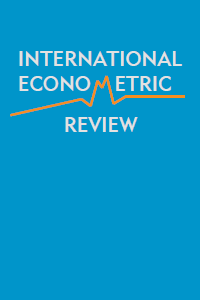A Comparison of Two Alternative Monetary Approaches to Exchange Rate Determination over the Long-Run
A Comparison of Two Alternative Monetary Approaches to Exchange Rate Determination over the Long-Run
The aim of this paper is to compare the conventional monetary model of the exchange rate with an alternative model, which incorporates a stock price measure and is based on Friedman‟s money demand function. These models are then compared using data from the UK, Canada and the USA, applying the Autoregressive Distributed Lag (ARDL) Bounds testing approach and the Phillips-Hansen approaches to cointegration. Although the results from the conventional monetary model are poor, the version which includes stock prices produces evidence of a long-run relationship, which has more appropriate long-run coefficients than the conventional model
Keywords:
Exchange Rate, Stock Price, ARDL Cointegration,
___
- Bahmani-Oskooee, M. and A. Sohrabian (1992). Stock prices and the effective exchange rate of the Dollar. Applied Economics, 24, 459-464.
- Bekaert, G. and C. Harvey (2000). Foreign speculators and emerging equity markets. Journal of Finance, 55, 565-613.
- Boyle, G.W. (1990). Money demand and the stock market in a general equilibrium model with variable velocity. Journal of Political Economy, 98, 1039-1053.
- Caruso, M. (2006). Stock market fluctuations and money demand in Italy, 1913–2003. Economic Notes, 35, 1-47.
- Cassola, N. and C. Morana (2004). Monetary policy and the stock market in the Euro area. Journal of Policy Modelling, 26, 387-399.
- Copeland, L. (2005). Exchange rates and International finance. Prentice Hall.
- Cushman, D. (2000). The failure of the monetary exchange rate model for the Canadian-US dollar. Canadian Journal of Economics, 33, 591-603.
- Dow, J. and D. Elmendorf (1998). The effect of stock prices on the demand for money market mutual funds. Federal Reserve Board.
- Ehrmann, M., M. Fratzscher and R. Rigobon (2005). Stocks, bonds money markets and exchange rates: measuring international financial transmission. NBER Working Paper No. 11166.
- Francis, B., I. Hasan, and J.R. Lothian (2001). The monetary approach to exchange rates and the behaviour of the Canadian dollar over the long run. Applied Financial Economics, 11, 475-481.
- French, K. and J. Poterba (1991). Investor diversification and international equity markets. American Economic Review, 81, 222-226.
- Friedman, M. (1956). The quantity theory of money- a restatement. In Studies in the Quantity Theory of Money, ed. M. Friedman. Chicago Univ: Chicago press.
- Friedman, M. (1988). Money and the Stock Market. Journal of Political Economy, 96 , 221- 245.
- Granger, C., B.-N. Huang and C.-W. Yang (2000). A bivariate causality between stock prices and exchange rates: evidence from recent Asian flu. Quarterly Review of Economics and Finance, 40, 337-354.
- Groen, J.J.J. (2000). The monetary exchange rate model as a long-run phenomenon. Journal of International Economics, 52, 299-319.
- Groen, J.J.J. (2002). Cointegration and the monetary exchange rate model revisted. Oxford Bulletin of Economics and Statistics, 64, 361-380.
- Griffin, J.M., F. Nardari and R.M. Stulz (2004). Are daily cross-border equity flows: pushed or pulled? Review of Economics and Statistics, 86, 641-657.
- Hau, H. and H. Rey (2006). Exchange rates, equity prices and capital flows. The Review of Financial Studies,19, 273-317
- Hsing, Y. (2007). Roles of the stock price and exchange rate in Slovakia‟s money demand function and policy implications. Transition Studies Review, 14, 274-282.
- Johansen, S. and K. Juselius (1990). Maximum likelihood estimation and inference on cointegration- with applications to the demand for money. Oxford Bulletin of Economics and Statistics, 52, 169-210.
- Mark, N.C. and D. Sul (2001). Nominal exchange rates and monetary fundamentals: Evidence from a small post-Bretton woods panel. Journal of International Economics, 53, 1, 29-52.
- Morley, B. (2007). The monetary model of the exchange rates and equities: An ARDL bounds testing approach. Applied Financial Economics, 17, 391-397.
- Pesaran, M.H. and Y. Shin (1999). An autoregressive distributed lag approach to Cointegration analysis. In Econometric and Economic Theory in the Twentieth Century, ed. S. Strom. Cambridge: Cambridge University press.
- Pesaran, M.H., Y. Shin and R.J. Smith (2001). Bounds testing approaches to the analysis of level relationships. Journal of Applied Econometrics, 16, 289-326.
- Phillips, P.C.B. and B.E. Hansen (1990). Statistical inferences in instrumental variables regression with I(1) processes. Review of Economic Studies, 57, 277-299.
- Rahbek, A. and R. Mosconi (1999). Cointegration rank inference with stationary regressors in VAR models. Econometrics Journal, 2, 76-91.
- Rapach, D. and M. Wohar (2002). Testing the monetary model of exchange rate determination: new evidence from a century of data. Journal of International Economics, 58, 359-385.
- Richards, A. (2005). Big fish in small ponds: The trading behavior and price impact of foreign investors in Asian emerging equity markets. Journal of Financial and Quantitative Analysis, 40, 1-27.
- Smith, C. (1992). Stock markets and the exchange rate: A multi-country approach. Journal of Macroeconomics, 14 , 607-629.
- Solnik, B. (1987). Using financial prices to test exchange rate models: A note. Journal of Finance, 42, 141-49.
- Tawadros, G. (2001). The predictive power of the monetary model of exchange rate determination. Applied Financial Economics, 11, 279-286.
- Wickens, M. (1996). Interpreting Cointegrating vectors and common stochastic trends. Journal of Econometrics, 74, 255-71.
- ISSN: 1308-8793
- Başlangıç: 2009
- Yayıncı: Ekonometrik Araştırmalar Derneği
